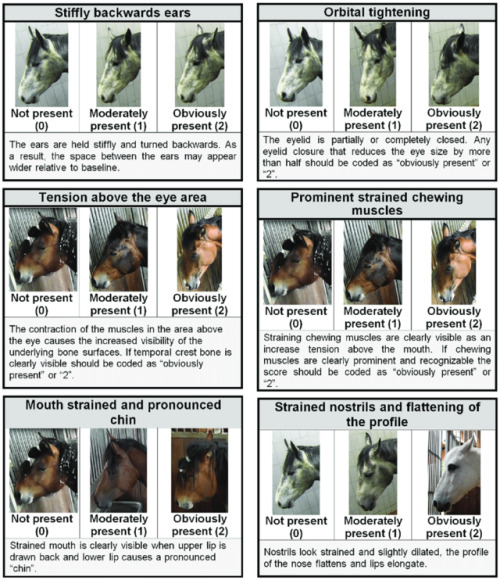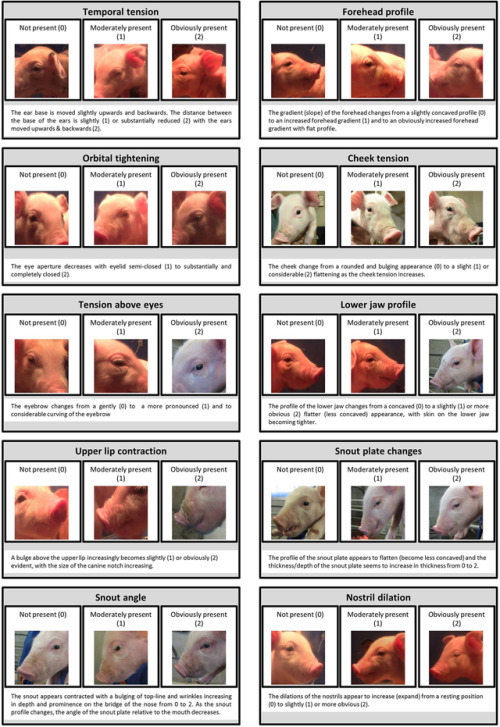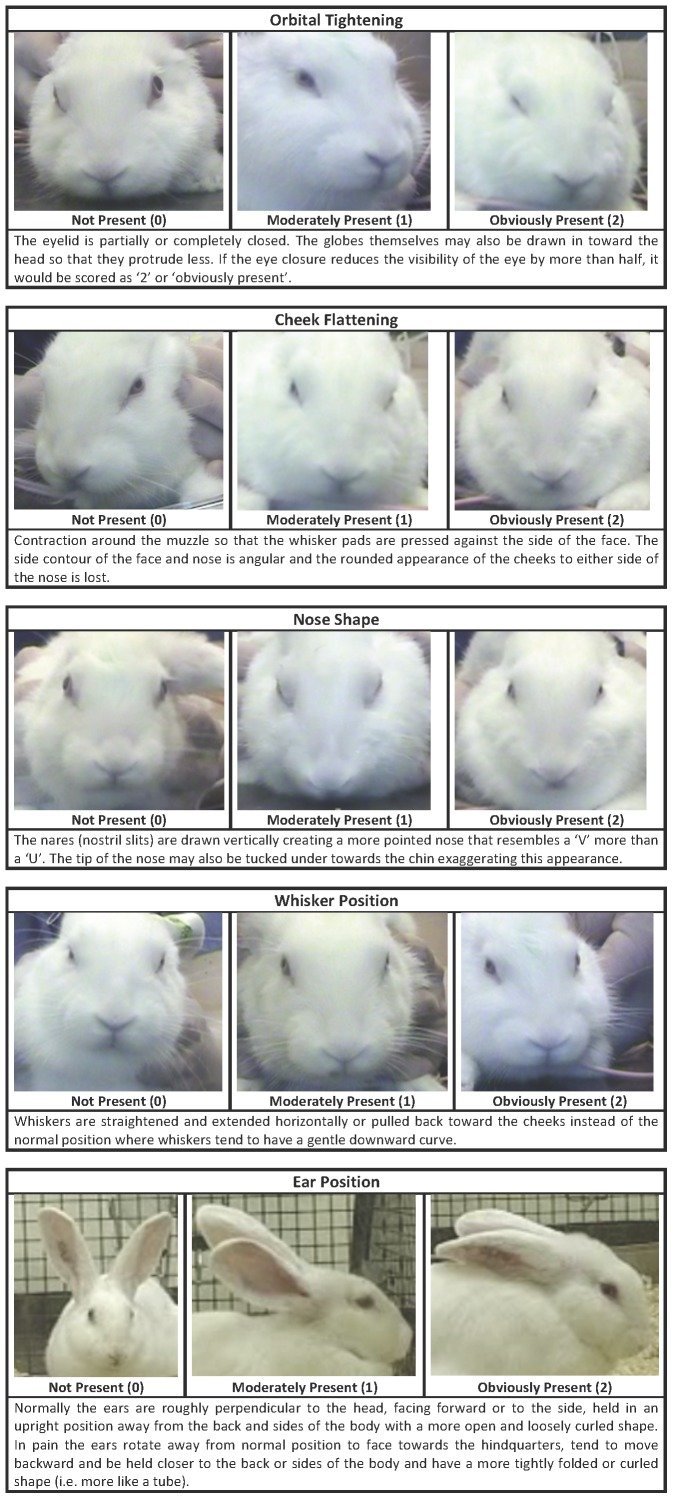Recognising Silent Acute Pain In Animals - Assorted Species Grimace Scales:









Recognising silent acute pain in animals - assorted species grimace scales:
Development of the Horse Grimace Scale (HGS) as a Pain Assessment Tool in Horses Undergoing Routine Castration
The composition and initial evaluation of a grimace scale in ferrets after surgical implantation of a telemetry probe
The Assessment of Facial Expressions in Piglets Undergoing Tail Docking and Castration: Toward the Development of the Piglet Grimace Scale
The Sheep Grimace Scale as an indicator of post-operative distress and pain in laboratory sheep and the Coding and quantification of a facial expression for pain in lambs
Mouse - How to be a pain management advocate for exotic and zoo animals (full text available - includes additional species)
The Rat Grimace Scale: A partially automated method for quantifying pain in the laboratory rat via facial expressions
Evaluation of EMLA Cream for Preventing Pain during Tattooing of Rabbits: Changes in Physiological, Behavioural and Facial Expression Responses
Pain evaluation in dairy cattle
Pain is subtle - we cannot depend on vocalisations or extreme abnormal behaviour to determine if an animal is on pain - animals can cover up pain while going about their daily life. Grimace scales have been found to be reliable indicators of pain (full text available)
Unfortunately, I could not find a clear visual grimace scale for dogs, cats or birds :(
Which is a shame, because perhaps I could have recognised my own dog’s discomfort for the acute pain it was sooner:

(left: dog in pain. See eyes, tension, cheeks, whiskers, ears compared to the multiple species grimace charts above. right: tired but not in pain dog)
Perhaps my new books that arrived today might have some on dogs at least. There’s this visual blog post of a stressed dog at the vet - stress in the absence of a trigger looks very much like pain.
Here is a small comparative cats, with the link going into more detail. Not a scale but better than nothing:


Bonus round - you can get free A3 posters on recognising pain for Rabbits, Mice and Rats from the National Centre for the Replacement, Refinement and Reduction of Animals in Research. My rabbit specialist vet has the rabbit one!
More Posts from Thejoyofscience and Others
panic! at the lab
ft hit songs such as
i write scribbles not lab reports
nine in the afternoon (nine in the evening? morning?) (oh it’s a 12 hr time point)
mad as grad students
high hopes (dissertation version)
For decades, scientists have been capitalizing off discoveries made from Henrietta Lacks’ family’s cells. That may change.


Urine sediment from a 6 year-old, male-intact, Rottweiler. The patient has a multi-year history of recurrent urinary tract infections. He recently presented to his primary care veterinarian for being unable to urinate. Radiographs showed no bladder stones, but a penile ultrasound showed many obstructing the urethra. The dog was then referred for surgery to relieve the obstruction…
*
The surgeons were kind enough to snag us some urine! The urine was full of these hexagonal crystals….consistent with cystine crystals! Yes, the amino acid cystine. In addition, there were all shapes of sperms (see them swimming in the background!) along with many inflammatory cells and some bacteria.
*
Diagnosis: Cystine crystalluria. This is a very rare occurrence in veterinary medicine! Such patient’s often have a genetic defect in the metabolism or transport of cystine, allowing the amino acid to accumulate in blood. Once it filters into urine, cystine will polymerize into crystals and sometimes form stones. Cystine stones do not obstruct x-rays…hence they cannot be found on standard radiographs (termed radiolucent). The patient is recovering well following surgery, and may require a special diet to help with his disease.
underappreciated form of humor: using incorrect long forms of proper names i.e. Craigory, Bobert, Barold, etc.


Cutaneous mass on the right flank of a 2 year-old, female-spayed, black Labrador Retriever. The owner noticed the mass approximately a week earlier, and it has been growing in size every day. On palpation, the lesion was quite painful. The dog also had a fever, at 103.5°F.
*
Fine needle aspiration revealed copious inflammatory cells. Mainly neutrophils, with lesser numbers of macrophages. Notice how some of the neutrophils appear ragged, some borderlining on unidentifiable? Such changes are consistent with a degenerative change, which usually occurs in the presence of a bacterial agent. And speaking of bacteria, there are TONS. A mixed collection of cocci and filamentous rods (red arrow). The presence of filamentous rods is often associated with plant foreign material (like a ‘grass awn’ or ‘cheat grass’).
*
Diagnosis: Marked, septic, suppurative inflammation with necrosis. Basically an abscess. A key piece of history…the patient is a hunting dog and partook in some field trials a few days before the mass developed. The patient is slated to have the mass surgically explored in hopes of finding planet debris.

Thumbs Up For Science
The cover of the legendary journal Nature from February 1879, featuring this thumb microscope, yours for the low, low price of three pounds.
(via Ptak Science Books, which you should really check out)



“What’s that on the beach?!"
Monterey Bay beachcombers and divers were treated to a huge bloom of salps this weekend! Salps are gelatinous filter-feeders that drift with and feed in the plankton. Wind and waves sometimes blow these open-ocean emissaries onshore by the thousands, a feast for fishes, invertebrates—and for the eyes of curious naturalists!
There were several species of salps in this weekend’s bloom, including these in the genus Salpa. Salps do not sting—in fact, they’re more closely related to fishes and people than they are to other "jellies”! The brown/orange orb is the salp’s gut. Pumping muscle bands push water from one end of the animal to the other through an internal plankton-pasta strainer.
Salps have an incredibly successful reproductive strategy, allowing them to explode in numbers when conditions are right. Ready? Here we go: Salps can be found as solos, or as a chain of dozens of individuals attached together. Same species, two different body morphs. The solos produce the chain asexually, and the individuals in the chain are all clones.
OK, still with us? The next part is a doozy: A young chain is female, and each female clone produces another solo salp from an egg that is fertilized by older male chains. The older male chains are female chains that changed sex as they aged—this is called sequential hermaphroditism. This whole process allows salps to produce new generations at an incredible rate, to take advantage of fleeting oceanic conditions. Phew, we did it!
Salps are thought to have an outsized effect on the flow of nutrients in the ocean’s food web. Because their fecal pellets sink, salp poop delivers vital nutrition from the ocean surface to the deep seafloor, and helps take carbon from the atmosphere to the deep, which helps regulate the planet’s climate. Spent salps from these huge blooms become food for countless organisms throughout the water column. Certain deep sea communities may even depend on these ephemeral feasts to survive in the desert of the abyssal plain, according to research by our colleagues at the Monterey Bay Aquarium Research Institute (MBARI).
This weekend’s salp bloom is a jiggly reminder of the vast community of gelatinous drifters—the gelata—that drift in the open ocean, connecting the surface to the deep and adjusting the Earth’s energy flow, unseen by most until a chance encounter on the shore.
Photo: Charles Schrammel Gif: Alison Smith


Menstruation products* but yeah real safety would be making them free as they should be 🙃
-
 purpleshorts reblogged this · 1 month ago
purpleshorts reblogged this · 1 month ago -
 mellowistapple liked this · 1 month ago
mellowistapple liked this · 1 month ago -
 mlleclaudine reblogged this · 1 month ago
mlleclaudine reblogged this · 1 month ago -
 mrscrocombe reblogged this · 1 month ago
mrscrocombe reblogged this · 1 month ago -
 mlleclaudine liked this · 2 months ago
mlleclaudine liked this · 2 months ago -
 eclectichellmouth reblogged this · 2 months ago
eclectichellmouth reblogged this · 2 months ago -
 cutequius reblogged this · 2 months ago
cutequius reblogged this · 2 months ago -
 cutequius liked this · 2 months ago
cutequius liked this · 2 months ago -
 whatevenisthisbloganymore reblogged this · 2 months ago
whatevenisthisbloganymore reblogged this · 2 months ago -
 thenextheraldmage reblogged this · 4 months ago
thenextheraldmage reblogged this · 4 months ago -
 radigirlized reblogged this · 4 months ago
radigirlized reblogged this · 4 months ago -
 radigirlized liked this · 4 months ago
radigirlized liked this · 4 months ago -
 tightlycoiledcutie liked this · 4 months ago
tightlycoiledcutie liked this · 4 months ago -
 fastwalker reblogged this · 4 months ago
fastwalker reblogged this · 4 months ago -
 dinosfarm reblogged this · 4 months ago
dinosfarm reblogged this · 4 months ago -
 anthiccesis-blog liked this · 6 months ago
anthiccesis-blog liked this · 6 months ago -
 belladonnafleur liked this · 6 months ago
belladonnafleur liked this · 6 months ago -
 raskies456 reblogged this · 6 months ago
raskies456 reblogged this · 6 months ago -
 itisataletoldbyalunatic reblogged this · 7 months ago
itisataletoldbyalunatic reblogged this · 7 months ago -
 105northtower liked this · 7 months ago
105northtower liked this · 7 months ago -
 saathi1013 liked this · 7 months ago
saathi1013 liked this · 7 months ago -
 neuromagpie reblogged this · 7 months ago
neuromagpie reblogged this · 7 months ago -
 neuromagpie liked this · 7 months ago
neuromagpie liked this · 7 months ago -
 madcelest liked this · 8 months ago
madcelest liked this · 8 months ago -
 janokenmun reblogged this · 8 months ago
janokenmun reblogged this · 8 months ago -
 janokenmun liked this · 8 months ago
janokenmun liked this · 8 months ago -
 rycake reblogged this · 8 months ago
rycake reblogged this · 8 months ago -
 artrefo reblogged this · 8 months ago
artrefo reblogged this · 8 months ago -
 candorgen reblogged this · 8 months ago
candorgen reblogged this · 8 months ago -
 candorgen liked this · 8 months ago
candorgen liked this · 8 months ago -
 macronectes reblogged this · 8 months ago
macronectes reblogged this · 8 months ago -
 ishrnmumbrella liked this · 8 months ago
ishrnmumbrella liked this · 8 months ago -
 heartsutra liked this · 8 months ago
heartsutra liked this · 8 months ago -
 radiohart reblogged this · 8 months ago
radiohart reblogged this · 8 months ago -
 radiohart liked this · 8 months ago
radiohart liked this · 8 months ago -
 unthinkingclunk reblogged this · 8 months ago
unthinkingclunk reblogged this · 8 months ago -
 officialrin liked this · 8 months ago
officialrin liked this · 8 months ago -
 otter-goddess liked this · 8 months ago
otter-goddess liked this · 8 months ago -
 princess-the-enchantress reblogged this · 8 months ago
princess-the-enchantress reblogged this · 8 months ago -
 wickedthemusicalaustralia liked this · 8 months ago
wickedthemusicalaustralia liked this · 8 months ago -
 ablogwithadog liked this · 8 months ago
ablogwithadog liked this · 8 months ago -
 osmanthusoolong liked this · 8 months ago
osmanthusoolong liked this · 8 months ago -
 schrodingers-redfish liked this · 8 months ago
schrodingers-redfish liked this · 8 months ago -
 saturniidaze reblogged this · 8 months ago
saturniidaze reblogged this · 8 months ago -
 bastardwordsmith liked this · 8 months ago
bastardwordsmith liked this · 8 months ago -
 frisky-apple liked this · 8 months ago
frisky-apple liked this · 8 months ago -
 ozzernexus liked this · 8 months ago
ozzernexus liked this · 8 months ago -
 itsbeartime liked this · 8 months ago
itsbeartime liked this · 8 months ago -
 papertrolejbus reblogged this · 8 months ago
papertrolejbus reblogged this · 8 months ago
An assortment of scientific things from the wonderful world of biology
77 posts

